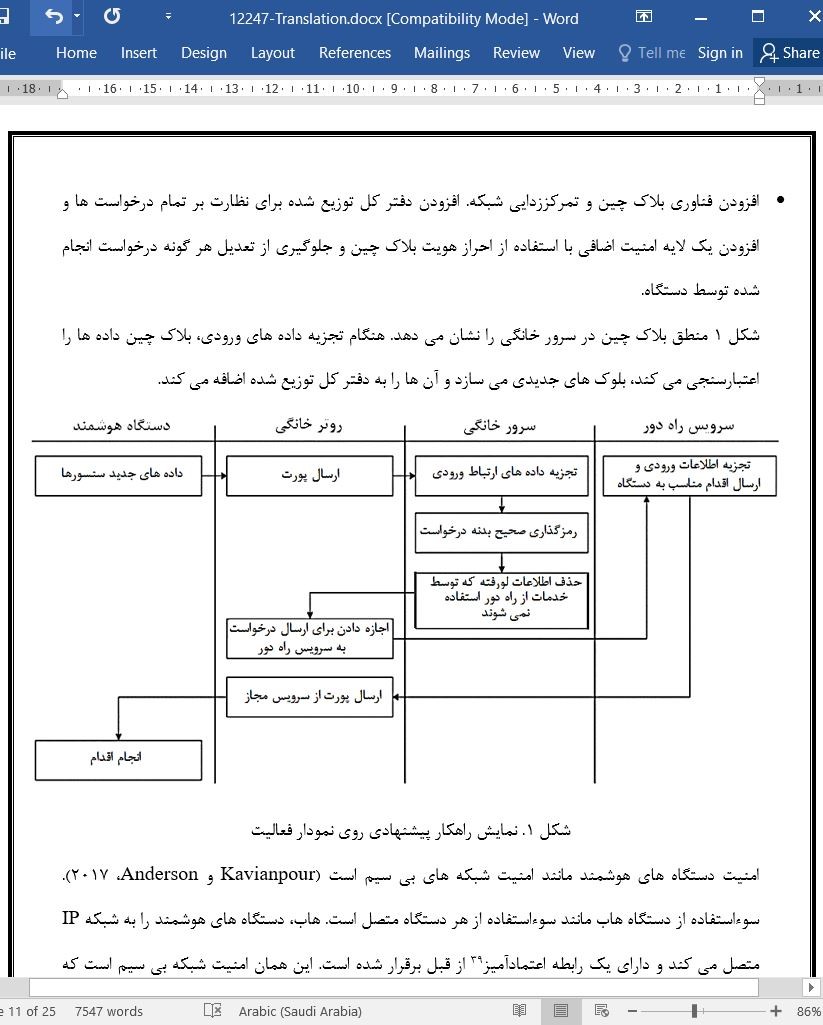
افزایش حریم خصوصی و امنیت با ادغام یک رابط امن بلاک چین
چکیده
اینترنت اشیاء و بلاک چین، به عنوان دو فناوری بزرگ مطرح شده اند. تاخیر کم تر و تعداد سیستم متصل بیش تر، انعطاف پذیری بیش تری را برای اجرای از راه دورِ اپلیکیشن های اینترنت اشیاء (IoT) فراهم می کند. بر کسی پوشیده نیست که ظرفیت رایانشِ اغلب دستگاه های IoT (هم از لحاظ توان پردازشی و هم از لحاظ الزامات ذخیره سازی)، برای پشتیبانی از الگوریتم های قابل اعتماد حفاظت و رمزگذاری کافی نیست. اینترنت اشیاء با چالش های بسیاری نظیر هم کنشپذیری ضعیف، آسیب پذیری های امنیتی، حریم خصوصی و فقدان استانداردهای صنعتی روبرو است. حملات سایبری به دستگاه های IoT می تواند بر حریم خصوصی و امنیت دادوستد انرژی تاثیر بگذارد. این مقاله روشی برای ارائه یک رابط اصلی برای معماری گذرگاه امنیتی دستگاه IoT همراه با بلاک چین پیشنهاد می دهد، تا تمرکز زدایی و احراز هویت مهیا شود. این مقاله، ویژگی های گم نامی و تطبیق پذیری، که به شدت لازم هستند، را به زیرساخت IoT اضافه می کند. IoT در حال حاضر فاقد این ویژگی هاست. این راهکار، از طریق اعمال الگوریتم های رمزنگاری سازگار به داده، قبل از این که داده ارسال شود، قابلیت اطمینان ارسال داده برای خدمات از راه دور را افزایش می دهد. مزایای این راهکار شامل این موارد است: سازگاری با تمام محصولات IoT و توانایی اجرای هر گونه الگوریتم رمزنگاری روی داده هایی که می توانند برای دادوستد ریزشبکه ای مورد استفاده قرار گیرند و می توانند مقداردهی اولیه شوند و به صورت امن از طریق زیرساخت های شبکه 5G و 6G منتقل شوند. به عنوان بخشی از این کار، یک رویه امنیتی ایجاد شده است که از تمام الگوریتم های رمزنگاری برای تمام دستگاه های IoT موجود در شبکه پشتیبانی می کند. علاوه بر این، رابط توسط فناوری بلاک چین محافظت می شود، که قدرت کنترل واحد را از بین می برد و تراکنش های تاریخی انجام گرفته توسط دستگاه های IoT را ثبت می کند و بین دستگاه ها اعتماد برقرار می کند.
1. مقدمه
دستگاه های IoT برای تبادل داده ها، نیاز به اتصال دائمی به اینترنت دارند، این امر باعث می شود که شبکه 5G از لحاظ تاخیرِ کم و حداکثر سرعت داده ی بالا، انتخاب بسیار خوبی باشد (Neves et al., 2017). شبکه های 5G کنونی، می توانند 106 دستگاه را در هر کیلومتر مربع با سرعت تاMbps 10 در کیلومتر مربع و ms1 تاخیر رفت و برگشت مقداردهی اولیه کنند و IoT با استفاده از شبکه های سیمی و بی سیم به چندین کامپیوتر و دستگاه متصل می شود. این مشخصاتِ شبکه های فعلی 5G باعث می شود که آن ها از لحاظ قابلیت دسترسی، گزینه فوق العاده ای برای اپلیکیشن های IoT باشند، اما باید خطرات را نیز مدنظر قرار داد و آن ها را به طور مناسبی مدیریت کرد.
Abstract
Internet of Things and Blockchain are considered two major technologies. Lower latency and a higher linked system number provide greater flexibility for remote execution of Internet of Things (IoT) applications. It is no secret that IoT devices often have insufficient computing capacity (both in terms of processing power and storage requirements) to support robust protection and encryption algorithms. The Internet of Things is facing many challenges such as poor interoperability, security vulnerabilities, privacy, and lack of industry standards. Cyber-attacks on IoT devices can have an impact on energy trading privacy and security. This paper suggests a method for introducing a basic interface to an IoT device’s security gateway architecture along with Blockchain to provide decentralization and authentication. It adds much-needed anonymity and versatility to IoT infrastructure, which is currently lacking. The solution enhances the reliability of data sent to remote services by applying compatible cryptographic algorithms to it before sending it. The solution’s benefits include compatibility with all IoT products and the ability to run any cryptographic algorithm on data that can be used for microgrid trading and can be initialized and securely transported over 5G or 6G network infrastructures. As a part of this work, a security procedure has been created that supports every cryptographic algorithm for all IoT devices in the network. In addition, the interface is guarded by the Blockchain technology which eliminates single control authority, records historical transactions performed by the IoT devices and provides a trust between devices.
1. Introduction
IoT devices need a persistent Internet connection to exchange data, making the 5G network an excellent choice in terms of low latency and high data peak speeds (Neves et al., 2017). Current 5G networks can initialize 106 devices per square kilometre with up to 10Mbps per square kilometre and 1 ms round-trip latency, and IoT connects to several computers and devices using wired and wireless networks. In terms of availability, these characteristics of current 5G networks make them an excellent option for IoT applications, but risks must be considered and handled properly.
چکیده
1. مقدمه
2. آخرین پیشرفت های علمی – کار مربوطه
3. راهکار پیشنهادی
4. امنیت، اعتماد و محدودیت های راهکار
5. ارزیابی امنیت
6. نتیجه گیری و کارهای آتی
منابع
Abstract
1. Introduction
2. State of the art — related work
3. Proposed solution
4. Security, trust, and solution limitations
5. Security evaluation
6. Conclusion and future works
Declaration of Competing Interest
References
- اصل مقاله انگلیسی با فرمت ورد (word) با قابلیت ویرایش
- ترجمه فارسی مقاله با فرمت ورد (word) با قابلیت ویرایش، بدون آرم سایت ای ترجمه
- ترجمه فارسی مقاله با فرمت pdf، بدون آرم سایت ای ترجمه



